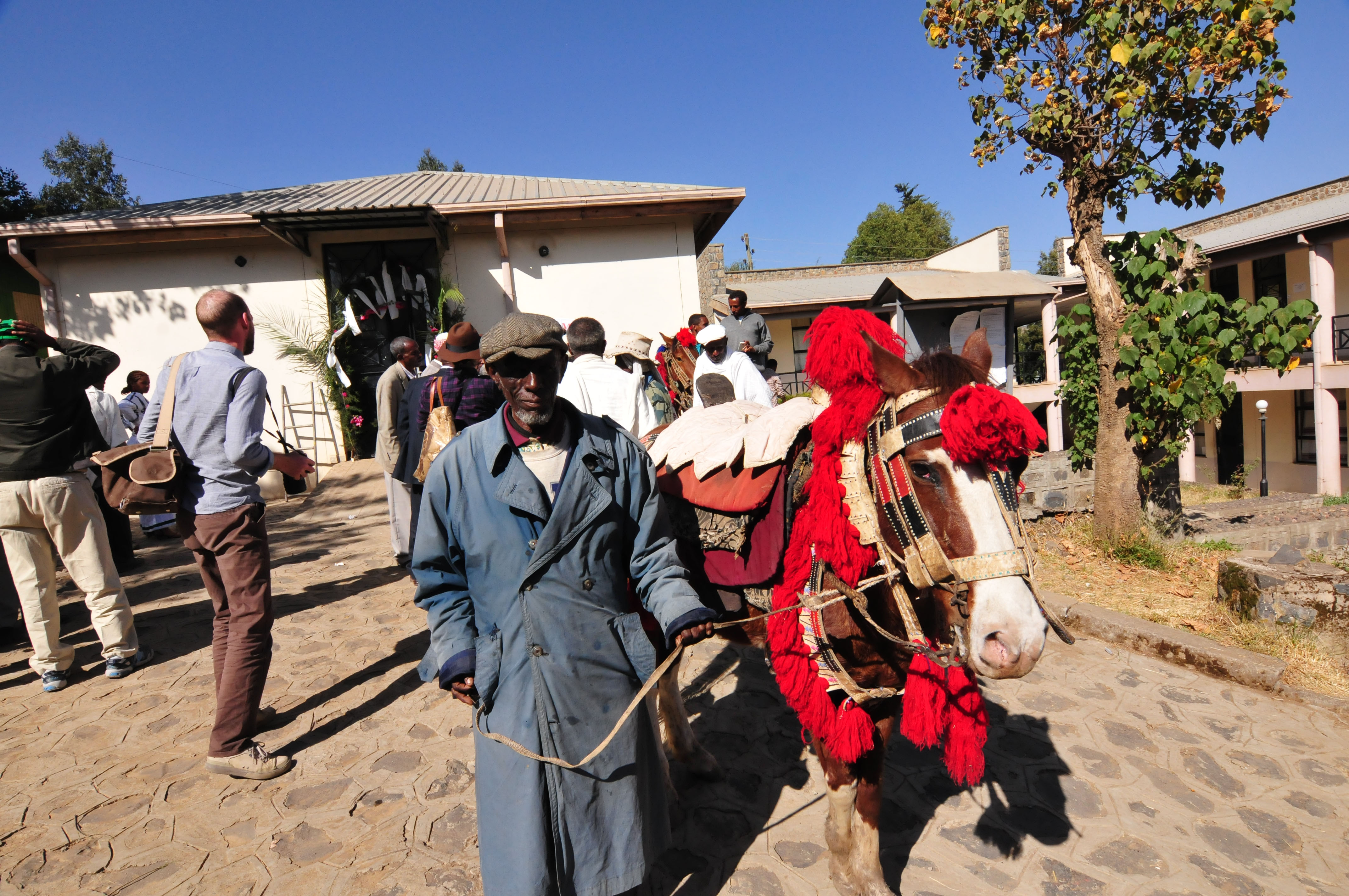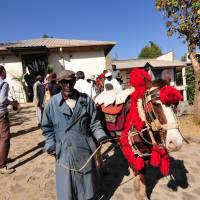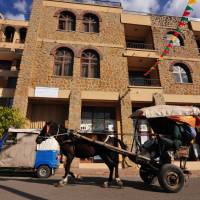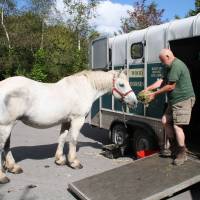As a wee nipper I'd sometimes be treated to donkey rides on our local beach at Port Talbot in South Wales, but the first time I sat astride a pony was near my home in Neath when I was 8. Around then, the old dairyman occasionally let me join him as he made his daily rounds with his horse-drawn cart collecting big metal churns of milk from the hill farms. On those great days we'd go from my grandparents' house on Llantwit Road up to my Auntie Peg Pritchard's cottage, then way up past the cemetery and the medieval-looking Ivy Tower, a stone folly from 1795 which to this day still overlooks the valley. The cart had a curved front and I would stand next to the old man as his horse plodded up the mountain road, imagining I was in a Celtic chariot riding into battle against the Romans.
When I was a boy, back in the 1940s and '50s, horses were still very much in use. In the big towns heavy Shire horses hauled four-wheeled carts delivering beer or coal, and even household milkmen, delivering bottles from door to door, used a horse-drawn cart. There was never any trouble with the dung, for as soon as a steaming pile was dropped, somebody would be out with a shovel or a dustpan to scoop it up and carry it to their garden.
In Wales, especially in the many hilly parts, tractors were slowly replacing horses back then, but I still have wonderful memories of summertime hay harvests, and of riding on a horse-drawn cart piled high with the fragrant mowed and sun-dried grass.
The more wealthy folk had fine saddles, but as a boy I rode bareback, on ponies, imagining that I was an Apache chief, a Mongol warrior, a knight off on a quest — or, not to be choosy, even one of the cowboys we loved to watch on Saturday-morning films at the cinema.
Then in 1967, horses and mules became an essential part of daily life again, when I first went into the Simien Mountains of northern Ethiopia to establish a national park there after being hired by the government as a game warden.
We used to leave our Land-Rover, Toyota or Mercedes Unimog truck in the police compound in the dusty little town of Debarek, then take horses or mules for the eight-hour trek high up into the mountains to our base camp at a place with panoramic views called Sankabar. Pack animals took all our supplies up there that way.
When I returned to Debarek for the first time in 45 years in January this year, two men on caparisoned horses rode ahead of our vehicle down the wide main street of that place grown beyond recognition. From there you can now drive into the heart of the Simien Mountains National Park, but everywhere you go you will see horses, mules and donkeys — and I sincerely pray that will always be so.
There, too, I was delighted that the simple two-wheeled gharry carts hauled by one small horse or a mule were still common in the towns, with a simple flat bed balanced over the axle. Used as taxis or for general deliveries, with just a little upgrading — and with better care taken of the animals — these would make great tourist attractions and conveyances both on roads and the better tracks
More recently, however, I returned from snowy Minami Aizu in southwestern Fukushima Prefecture, where friends in the forestry industry are taking up a dream I have for the northern part of Nagano Prefecture where I live outside Kurohime. That is to once again use horses to extract logs from areas unsuitable for heavy tracked vehicles.
Fifty years ago, the use of horses in this and many other forested mountain regions was quite normal in Japan, but apart from six working horse-loggers based in the central Iwate Prefecture town of Tono, the practice has almost died out. In Minami Aizu this time, it was heartwarming not only to see how children and photographers delighted in the working horses, but at how old folk came out, sometimes bringing with them some of their old tools, to tell us of their memories.
My dream is not only to see the widespread use of horses for forest work, but also to adapt safe carts and carriages for ecotourism. I would like to rig a large vehicle normally used to transport heavy logs on narrow forest trails with safe seats and roll bars so that we can give disabled children a horse-drawn woodland adventure. As well, it would be great to see the introduction of horse-trekking, with small hardy horses used to carry packs so that older or less fit folk can walk, picnic and camp out in the woods and hills just carrying their cameras and water bottles.
Humans' partnership with horses is ancient; horses began to be domesticated about 4,000 years ago and there are 3,000-year-old rock carvings from an early Tibetan culture that depict people mounted on horses. Once astride a horse your horizon expands. It can be argued that the spread of human civilization was triggered by the use of horses. I certainly believe that just being close to a horse, let alone working or playing with them, is therapeutic.
A few years ago in Wales, I had my first meeting with Doug Joiner, the chairman of British Horse Loggers. He was returning from a show in France to do another show in St. Fagan's Park, Cardiff, with his gentle gray Percheron mare, Ella. Together with my friends Christian and Natsuyo Searle, we agreed to meet at a service area just outside Cardiff with a car park bordered by trees and lawns. Ella had been let out of her trailer and was nibbling on grass and on feed that Doug put out for her,
A young mother was coming across the car park with her little boy, who appeared to have Down syndrome. When the lad saw Ella he started yelling at the top of his voice that he wanted to go and meet "horsey."
They came over to us, the mother looking embarrassed at the fuss her boy was making. Doug picked him up and said, "Would you like to say hello? Her name is Ella."
The sheer delight on that little boy's face when he stroked Ella's silky nose, and his mother's happy smile, is a scene I could never forget. It's remembering such reactions — and knowing what being close to horses can do for children, especially ones with special needs — that's one of my major reasons for wanting to have working horses in our woods.
Ella, whose full name was Lynside Eleanor, died on March 6 this year, with Doug beside her. They had worked together for 22 years, and as he said it they had many wonderful times together. Among those, though, perhaps the most memorable was being asked to deliver a Christmas tree to Clarence House in London, the official residence of HRH Prince Charles and the Duchess of Cornwall. Can you imagine it? Driving through the busy streets of the capital with a huge Christmas tree on a cart pulled by a great gray horse? You can bet the tourist cameras were clicking at quite a clip that day!
Ella was buried in a row of pear trees in the rural central England county of Herefordshire, facing south overlooking the beautiful Malvern Hills. The sadness felt at the loss of an animal partner, whether a horse, a dog or a cat, is part of the price we pay for the joy they give us during their lives — a joy I so much want to bring to our Afan Trust woods.
Some years ago, Mr. Matsuki, our now-retired forester, found a rusted horseshoe in the woods that he nailed to his woodland shed for good luck. I wonder what happened to the horse that wore it, and the man who worked the horse? Until we brought horses down from Tono to extract logs for us last year, there had been none in this area for 40 or 50 years. I know that during the war, when Japan was desperate for metal, they were used to drag sleds of red earth dug from one part of what's now our woods to be smelted for iron. By all accounts it was a rough, tough time for both men and horses. Now that area has been transformed with a watercourse and ponds, there's fine trees growing on the banks and the air now often rings with the laughter of children. That makes me doubly sure that the woods will welcome the horses back.




















With your current subscription plan you can comment on stories. However, before writing your first comment, please create a display name in the Profile section of your subscriber account page.